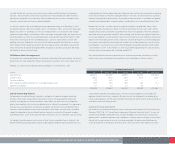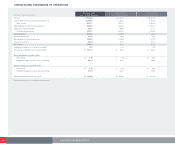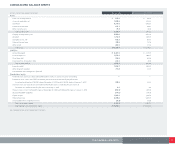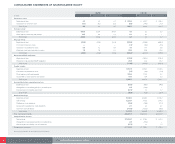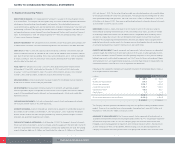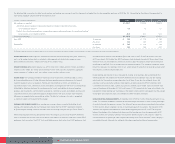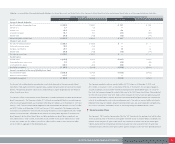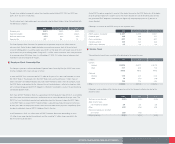CVS 2005 Annual Report Download - page 33
Download and view the complete annual report
Please find page 33 of the 2005 CVS annual report below. You can navigate through the pages in the report by either clicking on the pages listed below, or by using the keyword search tool below to find specific information within the annual report.
cash flows (undiscounted and without interest charges). If the estimated future cash flows used in this
analysis are less than the carrying amount of the asset group, an impairment loss calculation is prepared.
The impairment loss calculation compares the carrying amount of the asset group to the individual store’s
estimated fair value based on estimated future cash flows (discounted and with interest charges). If the
carrying amount exceeds the individual store’s estimated future cash flows (discounted and with interest
charges), the loss is allocated to the long-lived assets of the group on a pro rata basis using the relative
carrying amounts of those assets.
GOODWILL–The Company accounts for goodwill and intangibles under SFAS No. 142, “Goodwill and Other
Intangible Assets.” As such, goodwill and other indefinite-lived assets are not amortized, but are subject to
annual impairment reviews. See Note 3 for further information on goodwill.
INTANGIBLE ASSETS – Purchased customer lists are amortized on a straight-line basis over their estimated
useful lives of up to 10 years. Purchased leases are amortized on a straight-line basis over the remaining life
of the lease. See Note 3 for further information on intangible assets.
REVENUE RECOGNITION–The Company recognizes revenue from the sale of merchandise at the time the
merchandise is sold. Customer returns are immaterial. Service revenue from the Company’s pharmacy
benefit management segment, which is recognized using the net method under Emerging Issues Task
Force (“EITF”) Issue No. 99-19, “Reporting Revenue Gross as a Principal Versus Net as an Agent,” is
recognized at the time the service is provided. Service revenue totaled $201.8 million in 2005, $129.3
million in 2004 and $96.0 million in 2003. Premium revenue from the Company’s pharmacy benefit
management segment is accounted for under SFAS No. 113, “Accounting and Reporting for Reinsurance
of Short-Duration and Long-Duration Contracts,” and is recognized over the period of the contract in
proportion to the amount of insurance coverage provided. Premiums collected in advance are deferred.
Premium revenue totaled $91.6 million in 2005. There was no premium revenue in 2004 or 2003.
INSURANCE–The Company is self-insured for certain losses related to general liability, workers’
compensation and automobile liability. The Company obtains third party insurance coverage to limit
exposure from these claims. The Company is also self-insured for certain losses related to health and
medical liabilities.
The Company’s self-insurance accruals, which include reported claims and claims incurred but not
reported, are calculated using standard insurance industry actuarial assumptions and the Company’s
historical claims experience. During 2005, PharmaCare Management Services entered into certain risk-
based or reinsurance arrangements in connection with providing pharmacy plan management services.
Policies and contract claims include actual claims reported but not paid and estimates of health care
services incurred but not reported. The estimated claims incurred but not reported are calculated using
standard insurance industry actuarial assumptions based on historical data, current enrollment, health
service utilization statistics and other related information and are provided by third party actuaries.
VENDOR ALLOWANCES–The Company accounts for vendor allowances under the guidance provided by
EITF Issue No. 02-16, “Accounting by a Customer (Including a Reseller) for Certain Consideration Received
from a Vendor,” and EITF Issue No. 03-10, “Application of EITF Issue No. 02-16 by Resellers to Sales
Incentives Offered to Consumers by Manufacturers.” Vendor allowances reduce the carrying cost of
inventory unless they are specifically identified as a reimbursement for promotional programs and/or other
services provided. Funds that are directly linked to advertising commitments are recognized as a reduction
of advertising expense in the selling, general and administrative expenses line when the related advertising
commitment is satisfied. Any such allowances received in excess of the actual cost incurred also reduce
the carrying cost of inventory. The total value of any upfront payments received from vendors that are linked
to purchase commitments is initially deferred. The deferred amounts are then amortized to reduce cost
of goods sold over the life of the contract based upon purchase volume. The total value of any upfront
payments received from vendors that are not linked to purchase commitments is also initially deferred.
The deferred amounts are then amortized to reduce cost of goods sold on a straight-line basis over the
life of the related contract. The total amortization of these upfront payments was not material to the
accompanying consolidated financial statements.
STORE OPENING AND CLOSING COSTS– New store opening costs, other than capital expenditures, are
charged directly to expense when incurred. When the Company closes a store, the present value of
estimated unrecoverable costs, including the remaining lease obligation less estimated sublease income
and the book value of abandoned property and equipment, are charged to expense. The long-term portion
of the lease obligations associated with store closings was $406.3 million and $507.1 million in 2005 and
2004, respectively.
ACCUMULATED OTHER COMPREHENSIVE LOSS – Accumulated other comprehensive loss consists of
a minimum pension liability and unrealized losses on derivatives. The minimum pension liability totaled
$117.0 million pre-tax ($73.4 million after-tax) as of December 31, 2005. The unrealized loss on derivatives
totaled $26.7 million pre-tax ($16.9 million after-tax) as of December 31, 2005. The minimum pension liability
totaled $57.7 million pre-tax ($35.7 million after-tax) and $59.4 million pre-tax ($36.9 million after-tax) as of
January 1, 2005 and January 3, 2004, respectively. The unrealized loss on derivatives totaled $31.2 million
pre-tax ($19.8 million after-tax) as of January 1, 2005.
STOCK-BASED COMPENSATION–The Company accounts for its stock-based compensation plans under
the recognition and measurement principles of Accounting Principles Board (“APB”) Opinion No. 25,
“Accounting for Stock Issued to Employees,” and related interpretations. As such, no stock-based
employee compensation cost is reflected in net earnings for options granted under those plans since
they had an exercise price equal to the market value of the underlying common stock on the date of
grant. See Note 7 for further information on stock-based compensation.
31
NOTES TO CONSOLIDATED FINANCIAL STATEMENTS


